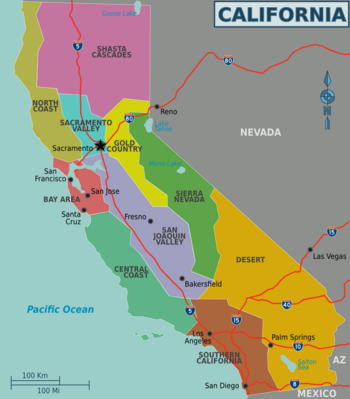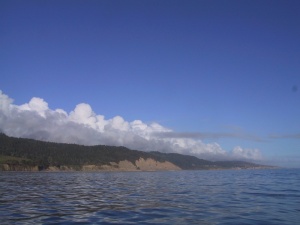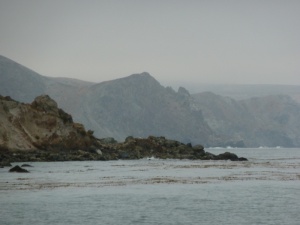California
From CruisersWiki
(→Coastal Passage Notes) |
(→San Francisco Bay to Point St. George) |
||
| Line 52: | Line 52: | ||
Refuge may be taken in Bodega Bay, Tomales Bay, Noyo River and Anchorage, Shelter Cove, Humboldt Bay, and numerous other small coves and bays. Hubolt Bay is the only deep-draft harbor. The other important places, all for small craft, are Bodega Harbor, Noyo River, Shelter Cove, and Crescent City Harbor. The coast is rugged and often mountainous, with many detached rocks. The principal dangers, all marked, are Blunts Reef, Redding Rock, and St. George Reef.<br> | Refuge may be taken in Bodega Bay, Tomales Bay, Noyo River and Anchorage, Shelter Cove, Humboldt Bay, and numerous other small coves and bays. Hubolt Bay is the only deep-draft harbor. The other important places, all for small craft, are Bodega Harbor, Noyo River, Shelter Cove, and Crescent City Harbor. The coast is rugged and often mountainous, with many detached rocks. The principal dangers, all marked, are Blunts Reef, Redding Rock, and St. George Reef.<br> | ||
| - | |||
*'''Fish Rocks''' | *'''Fish Rocks''' | ||
*'''Havors Anchorage''' | *'''Havors Anchorage''' | ||
*'''Russian River''' | *'''Russian River''' | ||
| + | *'''Bodega Bay''' | ||
*'''Tomales Bay''' | *'''Tomales Bay''' | ||
| + | *'''Drakes Bay''' | ||
==== Point Arguello to San Francisco Bay ==== | ==== Point Arguello to San Francisco Bay ==== | ||
Revision as of 01:52, 9 June 2012
California Cruising Guide
California adjoins the Pacific Ocean, Oregon, Nevada, Arizona, and the Mexican state of Baja California. With an area of 160,000 square miles (414,000 km2), it is the third-largest state in the United States in size, after Alaska and Texas. If it were a country, California would be the 59th-largest in the world in area. Along the California coast are several major metropolitan areas, including Greater Los Angeles, the San Francisco Bay Area, and San Diego.
As part of the Ring of Fire, California is subject to tsunamis, floods, droughts, Santa Ana winds, wildfires, landslides on steep terrain, and has several volcanoes. It sees numerous earthquakes due to several faults, in particular the San Andreas Fault.
Submit details about the sailing/cruising in the area, etc.
Charts
All official nautical paper charts produced by NOAA's Office of Coast Survey (OCS) are available in computerized format.
An interactive Chart Catalog is available on the NOAA site as well.
Radio Nets
Also see World Cruiser's Nets
Local Weather
The weather along this coast is mostly cool, damp, and foggy in the summer, becoming mild and wet in winter. Summer afternoons on the coast are often clear and pleasant. The dominant weather feature is the semipermanent Pacific high. In summer, it is big and strong and covers the entire region. Storms and fronts are forced to move along the N side, so few affect this coast. In winter, the high weakens and retreats SE. This allows storms or frontal systems to pass through the area about every 7 to 10 days, on the average. Sometimes a series of these systems may result in a prolonged period of strong winds and heavy rains along the central and southern California coast. This situation is rare and occurs about every 2 to 3 years.
Sources for Weather forecasts:
Special State Boating Bylaws or Restrictions
Information about boating in California is available via the California Department of Boating and Waterways website.
Ports and Popular Stops
- Crescent City
- Fort Bragg
- Los Angeles, CA (Long Beach) (Has data)
- Monterey, CA (Has data)
- San Diego, CA (Has data)
- San Francisco, CA (Has Data)
- Santa Cruz, CA
Offshore Islands and Groups
- The Farallon Islands, or Farallones (from the Spanish farallón meaning "pillar" or "sea cliff"), are a group of islands and sea stacks in the Gulf of the Farallones, off the coast of San Francisco, California, USA. They lie 27 miles (43 km) outside the Golden Gate and 20 miles (32 km) south of Point Reyes, and are visible from the mainland on clear days. [1]
- The Channel Islands of California are a chain of eight islands located in the Pacific Ocean off the coast of Southern California along the Santa Barbara Channel. Five of the islands are part of the Channel Islands National Park.
Coastal Passage Notes
California's coast is notorious for fog, navigational challenges, mercurial weather, and the dangers of its stark and rocky shore. Matching the extraordinary and challenging cruising conditions, the coast offers up views of whales, dolphins, sea otters and other marine life. Anchorages like Drake's Bay and Ano Nuevo offer cruisers a glimpse of herds of elephant seals and their predator, the great white shark. If traveling coast wise North-to-South, prevailing winds and currents are likely to make for an easier passage. Conversely, traveling up California's coast requires careful planning to round the headlands, with their increased wave size and winds, during best conditions.
Coastal Anchorages
Most anchorages along the California coast provide protection from the prevailing NW winds. Many of these anchorages become dangerous during southerly wind conditions as they provide no protection from southerly winds and swell. As wind conditions can change very quickly, the cruiser should closely monitor weather conditions while at anchor.
San Francisco Bay to Point St. George
Refuge may be taken in Bodega Bay, Tomales Bay, Noyo River and Anchorage, Shelter Cove, Humboldt Bay, and numerous other small coves and bays. Hubolt Bay is the only deep-draft harbor. The other important places, all for small craft, are Bodega Harbor, Noyo River, Shelter Cove, and Crescent City Harbor. The coast is rugged and often mountainous, with many detached rocks. The principal dangers, all marked, are Blunts Reef, Redding Rock, and St. George Reef.
- Fish Rocks
- Havors Anchorage
- Russian River
- Bodega Bay
- Tomales Bay
- Drakes Bay
Point Arguello to San Francisco Bay
Ports and Small Fishing Harbors where refuge may be taken include Port San Luis, and the small-craft and commercial fishing harbors of Morro Bay, Monterey, Moss Landing, Santa Cruz, and Pillar Point. The coast, except for the bays, is rugged with many detached rocks close inshore and other dangers extending no more than 2 miles offshore.
- Ano Nuevo refuge anchorage can provide shelter during NW gales while transiting the coast north of Santa Cruz Harbor and South of Pillar Point Harbor. Reference NOAA Chart 18680. Ano Nuevo is located 5 miles to the S of Pigeon Point Light; Ano Nuevo is an unmistakable landmark with sand dunes and a well known elephant seal rookery located adjacent an abandoned tower and white buildings near the tower. Approach from the N at least 1.5 miles off. There is a lighted buoy (Fl. R. 6 sec.) just S of the tower. A rolly anchorage lies S of Ano Nuevo in a bight. The anchorage is protected by the rocks and kelp which extend from the point to the SE. Anchorage depth is 4 to 7 fathoms mixed sand and rock. The best anchoring is in smooth waters due to the kelp. Sea otters may be seen throughout the anchorage among the kelp. If strong winds are from NW, a strong scent of the rookery will make the anchorage unpleasant. If winds and seas are from the W or S, the anchorage will be rolly and potentially dangerous. Last Visited & Details Checked (and updated here) Date of member's visit to this Port/Stop & this page's details validated: September 2010 --Redbopeep
- Wreck Beach refuge anchorage can provide shelter during NW gales while transiting the coast. 6.6nm SE Point Sur, 0.42nm E of Pfeiffer Rock, 42nm NNE Point Piedras Blancas. The the area of
 36°13.97′N, 121°48.12′W there are sandy patches devoid of kelp in which a vessel can anchor in 10-20m. Fishing vessels frequently use this anchorage. Unusable in W or S weather.
36°13.97′N, 121°48.12′W there are sandy patches devoid of kelp in which a vessel can anchor in 10-20m. Fishing vessels frequently use this anchorage. Unusable in W or S weather.
- San Simeon provides good anchorage during the prevailing NW weather or in settled conditions. 5nm ESE Point Piedras Blancas. 24nm NNE Morro Bay. 76nm SSE Monterey at
 35°38.43′N, 121°11.44′W. A small S facing bight protected by a point and a reef. The reef extends S to the buoy which should be sighted before attempting entry from either N or S. Anchor off the beach W of the pier in 5-10m. San Simeon may be safer to enter in NW gales than crossing the bar at nearby Morro Bay. There is a campground and grocery ashore. Hearst Castle, a popular tourist attraction, is nearby and may be visited via a local tour bus. The anchorage is lightly used with a sandy bottom so the holding is good. It is not rolly if the prevailing wind and sea direction is from the N-NW or East. Often a mild swell is evident along the abandoned pier on the E-NE side of the anchorage. It is a dangerous anchorage if a southerly is blowing. Approaching the anchorage from the north stay one mile off until sighting the marker bouy abeam on the port side. This is to avoid the kelp bed that lies to the NW and West of the anchorage. Enter the anchorage around the Southern edge of the kelp and then head North into the anchorage. Anchor in the NW corner of the bay fairly close to shore. There, the wind break of trees and cliff protect boats from prevailing NW winds. Landing a dingy is easiest near the NW area of the anchorage. Last Visited & Details Checked (and updated here) Date of member's visit to this Port/Stop & this page's details validated: September 2011 --Redbopeep
35°38.43′N, 121°11.44′W. A small S facing bight protected by a point and a reef. The reef extends S to the buoy which should be sighted before attempting entry from either N or S. Anchor off the beach W of the pier in 5-10m. San Simeon may be safer to enter in NW gales than crossing the bar at nearby Morro Bay. There is a campground and grocery ashore. Hearst Castle, a popular tourist attraction, is nearby and may be visited via a local tour bus. The anchorage is lightly used with a sandy bottom so the holding is good. It is not rolly if the prevailing wind and sea direction is from the N-NW or East. Often a mild swell is evident along the abandoned pier on the E-NE side of the anchorage. It is a dangerous anchorage if a southerly is blowing. Approaching the anchorage from the north stay one mile off until sighting the marker bouy abeam on the port side. This is to avoid the kelp bed that lies to the NW and West of the anchorage. Enter the anchorage around the Southern edge of the kelp and then head North into the anchorage. Anchor in the NW corner of the bay fairly close to shore. There, the wind break of trees and cliff protect boats from prevailing NW winds. Landing a dingy is easiest near the NW area of the anchorage. Last Visited & Details Checked (and updated here) Date of member's visit to this Port/Stop & this page's details validated: September 2011 --Redbopeep
San Diego to Point Arguello
- Cojo Anchorage provides good anchorage and shelter during NW wind conditions that can prevent a transit of nearby Point Conception. Cruisers Northbound often stop at Cojo Anchorage to wait for calm weather conditions to round both Points Conception and Arguello. The anchorage is located 1nm NE of Point Conception, 30nm W of Santa Barbara, 34nm NW of Santa Cruz Island, and 65nm SSE of Morro Bay. Anchorage may be taken directly off the prominent culvert under the railroad track that runs just behind the beach in the vicinity of
 34°26.97′N, 120°26.58′W. Often moored nearby is Mr. Clean, an oil spill cleanup vessel. Approaching the anchorage from the South, a mooring buoy for the oil service vessels lies just outside of the kelp beds. The kelp reduces wave action in the anchorage. In line with the mooring buoy and the prominent culvert is typically a passage through the kelp. Once inside the kelp in clear water, anchors may be set in 4 to 5 fathoms. A few small sailboats lie wrecked on the shore line as a reminder that no protection is available here from S or SE winds. The land ashore in this area is either private or part of the Vandenburg Air Force Base. There is no highway access here and no cellular phone service for this reason. There is often exceptional surfing in the area running several miles E of here.
34°26.97′N, 120°26.58′W. Often moored nearby is Mr. Clean, an oil spill cleanup vessel. Approaching the anchorage from the South, a mooring buoy for the oil service vessels lies just outside of the kelp beds. The kelp reduces wave action in the anchorage. In line with the mooring buoy and the prominent culvert is typically a passage through the kelp. Once inside the kelp in clear water, anchors may be set in 4 to 5 fathoms. A few small sailboats lie wrecked on the shore line as a reminder that no protection is available here from S or SE winds. The land ashore in this area is either private or part of the Vandenburg Air Force Base. There is no highway access here and no cellular phone service for this reason. There is often exceptional surfing in the area running several miles E of here.
- Santa Cruz Island Smuggler's Cove also known as Anacapa Bay is a large and easy to find anchorage that can provide shelter to several boats. This well-known anchorage is located on the SE side of the island in the vicinity of
 34°01.3′N, 119°32.6′W on NOAA Chart 1858. The approach from either Anacapa or from the S, the yellowish cliffs on the SE side of the island is visible for many miles in clear weather. The northern most cliffs are just SW of Smuggler's Cove. There is a grove of olive farm trees in rows on the hillside above the Cove. Steer for the part of the anchorage below these trees and anchor in the sandy bottom in 4 to 7 fathoms. Heavy ground tackle is recommended to anchor here as NW winds are funneled down-slope into the anchorage by the lay of the land. Beware of NE swells which can warn of a Southern California Santa Ana wind. This anchorage is not safe for such conditions nor for SE gales. Last Visited & Details Checked (and updated here) Date of member's visit to this Port/Stop & this page's details validated: May 2010 --Redbopeep
34°01.3′N, 119°32.6′W on NOAA Chart 1858. The approach from either Anacapa or from the S, the yellowish cliffs on the SE side of the island is visible for many miles in clear weather. The northern most cliffs are just SW of Smuggler's Cove. There is a grove of olive farm trees in rows on the hillside above the Cove. Steer for the part of the anchorage below these trees and anchor in the sandy bottom in 4 to 7 fathoms. Heavy ground tackle is recommended to anchor here as NW winds are funneled down-slope into the anchorage by the lay of the land. Beware of NE swells which can warn of a Southern California Santa Ana wind. This anchorage is not safe for such conditions nor for SE gales. Last Visited & Details Checked (and updated here) Date of member's visit to this Port/Stop & this page's details validated: May 2010 --Redbopeep
Cruiser's Friends
Contact details of "Cruiser's Friends" that can be contacted for local information or assistance.
Forum Discussions
List links to discussion threads on partnering forums. (see link for requirements)
- Transiting the Pacific Coast
- Pics Sailing from San Diego to San Francisco
- San Francisco to San Diego
- Strategies for Northbound Pacific Passage
External Links
Links to relevant websites.
References & Publications
Publications, Guides, etc.
Personal Notes
Personal experiences?
Last Visited & Details Checked (and updated here)
Date of member's visit to this Port/Stop & this page's details validated:
|
|---|
| |
|---|
| | HOMEPAGE | Wiki Contents | United States | California | |


